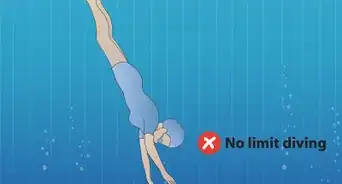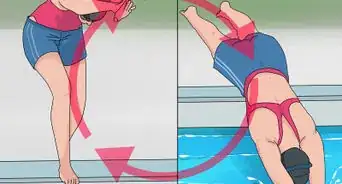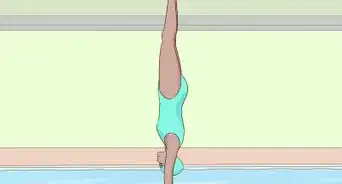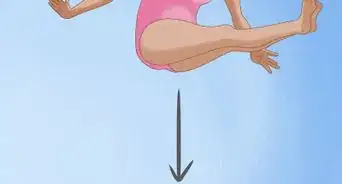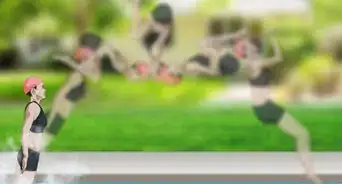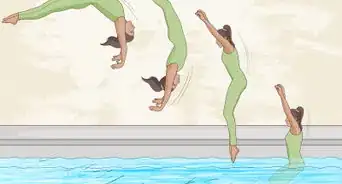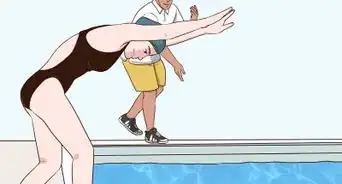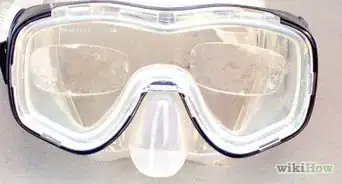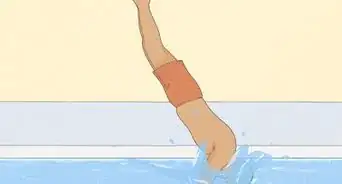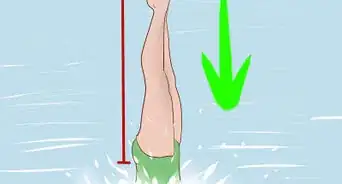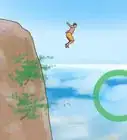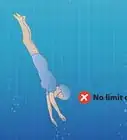This article was co-authored by Brad Hurvitz. Brad Hurvitz is a Certified Swimming Instructor for My Baby Swims, an adolescent swimming school based in La Jolla, California. Brad is trained as an Infant Swimming Resource (ISR) instructor with ISR's Self-Rescue® program. He specializes in training children aged six months to six years of age survival skills like floating on their back to breathe and swimming back to the wall, while also educating parents on how to better keep their kids safe. He has a Master of Business Administration from Oregon State University.
wikiHow marks an article as reader-approved once it receives enough positive feedback. This article has 11 testimonials from our readers, earning it our reader-approved status.
This article has been viewed 552,071 times.
Diving headfirst feels exhilarating, and since it helps you swim faster and reach further depths, it opens up a whole new side of swimming in the pool. Learning to dive can be a little nerve-wracking at first, but good technique can help you can make the process easier.
Steps
Working Up to Diving
-
1Find a deep diving pool. Since diving means entering a pool headfirst, the water has to be deep enough so that you don't hit the bottom too quickly and risk getting a head or spine injury. The Red Cross considers nine feet to be a good depth for diving if you want to be especially cautious, but the diving area in many pools is eight feet deep. Never dive into a pool that's less than eight feet deep.[1]
- If you're unsure how deep a pool is, it's best to avoid diving there. It can be hard to gauge a pool's depth just by looking. Find a pool where the depth of the water is clearly marked. In many cases there will also be a sign posted that specifies diving is permitted there.[2]
- Avoid diving into lakes, ponds and other natural bodies of water unless the area is supervised and has been cleared for diving. The depth of the water in these natural places is very inconsistent, and there may be boulders hiding in the water that you can't see from the shore.[3]
-
2Get used to the thought of diving in headfirst. Many beginner divers, especially kids, are afraid to dive at first. It makes sense, since in any other situation launching toward something headfirst would result in pain and injury. If you're nervous about taking the plunge, try these techniques to feel more comfortable with the idea:
- Jump into the water feet first, so you get used to the feeling of entering water from a height. Sometimes kids think that water is hard, so it can help to point out to them that it's soft as you encourage them to splash around.
- Practice falling while you're in the water. Stand up in the water and let yourself fall forward, then let yourself fall backward. See how the water "catches" you and prevents you from getting hurt.
Advertisement -
3Do a dry run on land before diving into water. Since diving can be intimidating when you're a beginner, it helps to practice on land and visualize how the dive will go before you enter the water. Stand upright with your arms straight above your head, your upper arms hugging your ears. Keep your hands flat and place one palm over the other. Tuck in your chin. This is the way your upper body should be composed when you dive into the water.
- You can practice the motion of diving on land as well. Find a grassy area or practice indoors on soft carpet. Get down on one knee and angle your arms and fingertips toward the ground. Roll forward so that your hands touch the ground, followed by your arms. Keep going until you're flat on your belly.
- Remember to hold your hands flat and place one on top of the other, rather than clasping them. Tucking your chin into your chest is equally important. These actions help to streamline your body, making your entry into the water smoother.
-
4Crouch close to the pool and glide into the water. Stand with your toes slightly over the edge of the pool, and crouch down close. Put your arms in position over your head - remember to tuck in that chin! - and point your hands toward the water. Now rock your body forward and gently glide into the water headfirst. As your legs follow your upper body, straighten them out and point your toes.
- As you enter the water, exhale, then hold your breath. You might accidentally inhale underwater if you feel startled, but once you get the hang of diving it'll feel natural to hold your breath.[4]
- Practice diving from a crouch until you feel completely comfortable entering the water this way. Once it starts to feel easy and you're ready to move on, you can dive from a standing position.
-
5Dive from a standing position. When you're ready to try it standing up, edge close to the pool so that your toes are at the edge. Get your arms and hands in position and bend at the waist, pointing your fingers toward the water. Face the direction you want to dive, tuck in your chin, and then tilt forward into the water. As your legs follow your upper body, keep them together and point your toes.[5]
- Consider having a spotter help you the first few times. The act of diving from a standing position can be a little intimidating, and it might help to know that someone else is there to help you. Have the person stand next to you and place one hand on your belly and the other on your back, so that he or she can guide you into the water.
- Once you can dive from a standing position without needing a spotter, you're ready to advance to learning a proper dive using the correct form. Soon you'll be leaping into the water without a second thought!
Diving With Good Form
-
1Place your lead foot over the rim of the pool. If you're right-handed, your lead foot will be your right foot, and if you're left-handed it will be your left foot. Place your lead foot slightly in front of your back foot, so your toes slightly jut over the pool. Your back foot should be flat on the ground, with your weight balanced equally over your feet. This is the starting position for a dive.
- As you work on your diving form, try to start with your feet in the exact same place every time. If you dive off of a diving board you may want to mark the spot where your feet should go to help you practice.
- Once you're comfortable diving from a stationary position, you can work up to doing a walking or running dive. This involves taking three or five steps forward, then leaping off of your lead foot into your dive.
-
2Point your arms above your head. Just as you did when you first practiced on land, raise your arms above your head, with your elbows straight. Tuck your upper arms against your ears. Hold your hands flat, with one palm resting over the back of your other hand. Hold your arms and hands in this position until you're ready to dive.
- As always, remember to keep your chin tucked down to your chest.
- If you do a walking or running dive, you'll start with your arms at your side, but they should always end up in an upright position before you enter the water.
-
3Push off and dive into the pool. Rather than tipping forward and falling in, push off with your lead foot to add distance to your dive. Enter the water fingertips first. Keep your body straight as you dive, with your legs together and your toes pointed. Once your body is fully in the water, you can start swimming or immediately come up for air.
- Remember to exhale as you enter the water and hold your breath while you're in. You should be able to swim around for several seconds before needing to surface.
- Try walking or running into your dive if you want to dive further and faster. No matter how you start your dive, your body should always enter the water at the same angle and using the same basic form.
Trying Advanced Dives
-
1Dive off of a starting block. In competitive swimming, races begin with a dive off of a starting block, raised slightly above the surface of the pool. To dive from this position, you start in a crouch, gripping the edge of the block with both your fingers and your toes. When the starting bell or shot sounds, you spring into a low dive and start swimming the moment you hit the water.
- When you're diving off of a starting block, it's important to streamline your body so that you enter the water with as little splashing as possible. Keep your body in a straight line and point your toes. This will minimize the water's drag on your body so you won't lose precious seconds during the race.
-
2Dive from the high board. When you've gotten comfortable from diving from the side of the pool, you might want to try it from a diving board. Diving off the low board isn't too different from the side of the pool, but the high board is a different story. It's usually about 10 feet (3.0 m) above the water, and requires climbing a ladder to get to the top.
- Make sure the high dive is above very deep water, since you'll be entering the water faster. The water should be at least 12 feet (3.7 m) deep to be on the safe side.
- You can use the same basic diving form to dive off the high dive as you'd use any other time. The key is to enter the water at an angle that gives you a smooth entry. If you lay out too flat, you'll end up doing a painful belly flop.
-
3Learn to hurdle off a diving board. This is the proper term for starting a dive from a walk or run. You take three to five steps, followed by a one-legged jump before entering the water. Hurdling is done before any type of advanced dive that requires gaining height in order to move or contort your body before you actually enter the water.[6] To hurdle, do the following:
- Start at the back of the diving board and take three to five steps. Three will give you plenty of momentum for a good hurdle, but you can take five if you have shorter legs or feel more comfortable taking more steps.
- On the last step, you should be near the end of the diving board. Lunge and jump, swinging your arms upward at the same time. Don't jump off the diving board; jump straight into the air.
- Land on the diving board with your feet in position to dive and your arms over your head. Now you're ready to jump off of the diving board and execute your dive.
-
4Do a jackknife. This advanced dive looks elegant and is a good next step once you've mastered the basic dive. Your body will rise up from the board, fold forward at the hips, then straighten into a dive. To do a jackknife, follow these steps:
- Begins with a hurdle. Take three to five steps, lunge and jump, and land on the edge of the board with your arms over your head. Jump off and slightly away from the diving board.
- Raise your hips above shoulder level as you jump off the board.
- Reach your arms down toward your toes. Your body should look like and upside-down V.
- Straighten your body to complete the dive.
Community Q&A
-
QuestionHow do I avoid belly flopping into a pool?
 Community AnswerYou just have to practice and focus on bending your body the right way so that your body enters the water at an angle instead of straight down. A belly flop is often caused by someone not entering the water at a sharp enough angle, so make sure to aim straight downwards.
Community AnswerYou just have to practice and focus on bending your body the right way so that your body enters the water at an angle instead of straight down. A belly flop is often caused by someone not entering the water at a sharp enough angle, so make sure to aim straight downwards. -
QuestionHow do you make sure you are diving properly?
 Community AnswerThe only real sure way is to have a coach or experienced diver watch and critique you, then help you to make necessary adjustments. It can be worth paying for a few lessons to ensure this. Other than that, you could watch videos on diving. When diving, check that you're not hurting yourself on entry, not making large splashes and that you're entering the water in a streamlined fashion.
Community AnswerThe only real sure way is to have a coach or experienced diver watch and critique you, then help you to make necessary adjustments. It can be worth paying for a few lessons to ensure this. Other than that, you could watch videos on diving. When diving, check that you're not hurting yourself on entry, not making large splashes and that you're entering the water in a streamlined fashion. -
QuestionDoes your pool need to be a certain depth?
 Community AnswerYes, as it says in Step 1, part 1, the pool must be deep or you risk a head or spinal injury. The Red Cross considers nine feet to be a good depth for diving if you want to be especially cautious, but the diving area in many pools is eight feet deep. Never dive into a pool that's less than eight feet deep. And if diving from the high board, the high dive must be above very deep water, since you'll be entering the water faster. The water should be at least 12 feet (3.7 m) deep, to be on the safe side.
Community AnswerYes, as it says in Step 1, part 1, the pool must be deep or you risk a head or spinal injury. The Red Cross considers nine feet to be a good depth for diving if you want to be especially cautious, but the diving area in many pools is eight feet deep. Never dive into a pool that's less than eight feet deep. And if diving from the high board, the high dive must be above very deep water, since you'll be entering the water faster. The water should be at least 12 feet (3.7 m) deep, to be on the safe side.
References
- ↑ https://www.health.ny.gov/environmental/outdoors/camps/aquatics/minimum_water_depths_for_head_first_diving.htm
- ↑ https://www.statefarm.com/simple-insights/family/swimming-and-water-safety-tips
- ↑ https://www.statefarm.com/simple-insights/family/swimming-and-water-safety-tips
- ↑ https://www.swim-teach.com/going-underwater-without-holding-your-nose.html
- ↑ https://blog.myswimpro.com/2021/05/27/how-to-dive-into-a-pool-beginner-tips/
- ↑ https://theconversation.com/not-making-a-splash-the-anatomy-of-a-perfect-olympic-dive-8082
About This Article
To dive into a pool, start by placing your lead foot over the rim of the pool and raising your arms straight above your head. Then, push off with your lead foot and dive head first into the pool so your hands enter the water first. To do a jackknife dive, start by taking a few steps forward on a diving board and then lunging and jumping so you land right on the end. Then, jump off the diving board and reach your arms down to your toes so you look like an upside-down V. Finally, straighten out your body and dive into the water. To learn how to practice diving, read on!



